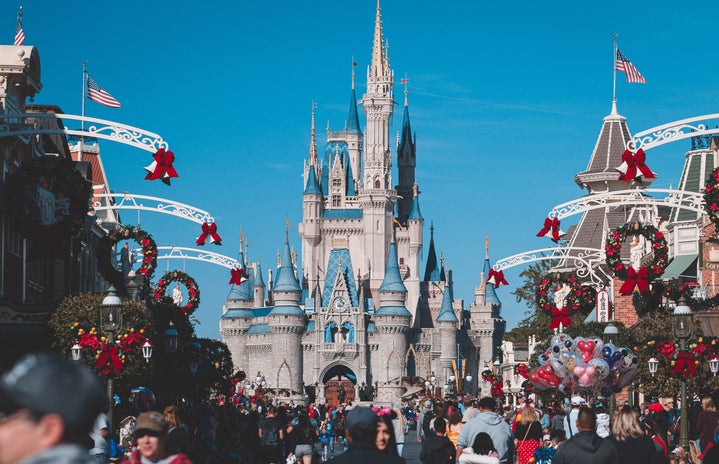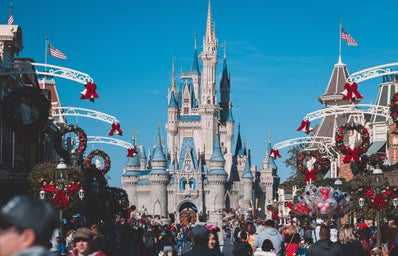Once upon a time, in a land far far away, there was a little girl with flaming orange hair glued to her TV screen, watching the same movie for what must have been the hundredth time in a row. As a natural redhead, I think it makes perfect sense that my three-year-old-self decided that her role model was going to be a fiery redheaded mermaid who brushes her hair with a fork and defies the one adult figure in her life with the help of her talking-fish sidekicks. From pressing my legs together and flopping them up and down in my swimming lessons, to trying to emulate her flowing hair by plunging my head underwater in the bath, I wanted to be her desperately.
I didn’t care that The Little Mermaid (1989) had Ariel fall in love at first sight with someone she technically doesn’t speak two words to until the end of the movie. Nor did I care when Beauty and the Beast’s (1991) Belle dabbles in a little Stockholm syndrome, or that Cinderella in the 1950 classic achieves her freedom with the helping hand of her Prince Charming. I cared that they were kind, smart and hard-working. I cared that they harboured fierce and headstrong desires to make for themselves a future bigger and better than the lives they had. And, of course, I cared that they could talk to animals too.
However, there has been recent criticism surrounding the old classic Disney tendency to have the heroine’s happy-ending coincide with falling in love with a prince. In an interview back in 2022, actress Rachel Zegler, cast as Snow White in Disney’s upcoming 2025 remake, claimed that instead of “dreaming about true love” as in the 1937 original, the princess was instead going to be “dreaming about the leader she knows she can be”.
Zegler is not the only one who thinks that the original Disney princesses are rooted in sexist ideology. Emma Watson, who played Belle in the Beauty and the Beast (2017) remake, rejected being cast as Cinderella back in 2015 in belief that the princess wasn’t a good enough role model for young girls. Actress Keira Knightley defiantly forbids her daughter from watching The Little Mermaid (1989) as it supposedly encourages young women to “wait around until a rich man comes and rescues her”.
Even Disney themselves have tried to adapt their princesses to cater towards quasi-feminist standards within their live-action remakes over the past decade. Watson’s Belle, for example, is the inventor in the film instead of her father as in the original, and Hallé Bailey’s Ariel in the recent 2023 remake is the one to defeat Ursula, not Eric. These changes at first glance may seem like passable attempts at empowering their heroines, but they only further perpetuate the concepts put forward by “girlboss feminism” – a form of “exclusionary politics” that “advocates individual successes” and detaches women “from what it means to be human”. Through “girlbossing” their princesses, Disney conforms to the patriarchal ideal that women can only be successful if they are dominant leaders. That, essentially, women can only be considered good role models for the younger generation if they possess masculine values and bury their femininity into the mud.
That’s not to say that I believe that we should consider the original, classic Disney princesses to be unproblematic feminist icons. But what those who criticise them seem to misunderstand is that falling in love and being independent from men are two things that can mutually coexist. You can prioritise having romantic love in your life while also being strong and self-sufficient. Can Snow White be a leader and also fall in love? Mulan (1998) certainly proves that women can do both. But why does Snow White have to be a leader at all?
During my early teenage years, the classic Disney Princess movies acted as nostalgic comfort blankets for me to wrap up in after a bad day at school. But they also acted as affirmations that my femininity was anything but subordinate. I could daydream about romance and what it would be like to wear a sparkly ball gown while also being self-reliant. I could prioritise gentleness over harshness, kindness over aggression and spectatorship over leadership – and absolutely none of this was inadequate.
Before Cinderella even meets Prince Charming at the ball, she withholds defiant faith even in the face of the most dire of circumstances. Before Belle meets Prince Adam, she’s kind, smart, and a caring daughter. Ariel desires to break free from the boundaries of her underwater life long before she even sets eyes on Prince Eric, and her headstrong curiosity and playfulness remains willfully intact throughout the 1989 original. They all just also happen to fall in love within their stories.
The Disney Princess franchise has been a childhood staple for young girls for decades and I’m sure that the remakes are allowing for an entirely new generation to fall in love with them, just like my three-year-old-self had done. I hope that, despite recent criticisms, and despite Disney’s lame attempts at “girlbossification”, the message that they assured me from a young age still remains intact – that effeminacy does not equal inadequacy.
Once upon a time, in a land far far away, there was a little girl with flaming orange hair glued to her TV screen, watching the same movie for what must have been the hundredth time in a row. As a natural redhead, I think it makes perfect sense that my three-year-old-self decided that her role model was going to be a fiery redheaded mermaid who brushes her hair with a fork and defies the one adult figure in her life with the help of her talking-fish sidekicks. From pressing my legs together and flopping them up and down in my swimming lessons, to trying to emulate her flowing hair by plunging my head underwater in the bath, I wanted to be her desperately.
I didn’t care that The Little Mermaid (1989) had Ariel fall in love at first sight with someone she technically doesn’t speak two words to until the end of the movie. Nor did I care when Beauty and the Beast’s (1991) Belle dabbles in a little Stockholm syndrome, or that Cinderella in the 1950 classic achieves her freedom with the helping hand of her Prince Charming. I cared that they were kind, smart and hard-working. I cared that they harboured fierce and headstrong desires to make for themselves a future bigger and better than the lives they had. And, of course, I cared that they could talk to animals too.
However, there has been recent criticism surrounding the old classic Disney tendency to have the heroine’s happy-ending coincide with falling in love with a prince. In an interview back in 2022, actress Rachel Zegler, cast as Snow White in Disney’s upcoming 2025 remake, claimed that instead of “dreaming about true love” as in the 1937 original, the princess was instead going to be “dreaming about the leader she knows she can be”.
Zegler is not the only one who thinks that the original Disney princesses are rooted in sexist ideology. Emma Watson, who played Belle in the Beauty and the Beast (2017) remake, rejected being cast as Cinderella back in 2015 in belief that the princess wasn’t a good enough role model for young girls. Actress Keira Knightley defiantly forbids her daughter from watching The Little Mermaid (1989) as it supposedly encourages young women to “wait around until a rich man comes and rescues her”.
Even Disney themselves have tried to adapt their princesses to cater towards quasi-feminist standards within their live-action remakes over the past decade. Watson’s Belle, for example, is the inventor in the film instead of her father as in the original, and Hallé Bailey’s Ariel in the recent 2023 remake is the one to defeat Ursula, not Eric. These changes at first glance may seem like passable attempts at empowering their heroines, but they only further perpetuate the concepts put forward by “girlboss feminism” – a form of “exclusionary politics” that “advocates individual successes” and detaches women “from what it means to be human”. Through “girlbossing” their princesses, Disney conforms to the patriarchal ideal that women can only be successful if they are dominant leaders. That, essentially, women can only be considered good role models for the younger generation if they possess masculine values and bury their femininity into the mud.
That’s not to say that I believe that we should consider the original, classic Disney princesses to be unproblematic feminist icons. But what those who criticise them seem to misunderstand is that falling in love and being independent from men are two things that can mutually coexist. You can prioritise having romantic love in your life while also being strong and self-sufficient. Can Snow White be a leader and also fall in love? Mulan (1998) certainly proves that women can do both. But why does Snow White have to be a leader at all?
During my early teenage years, the classic Disney Princess movies acted as nostalgic comfort blankets for me to wrap up in after a bad day at school. But they also acted as affirmations that my femininity was anything but subordinate. I could daydream about romance and what it would be like to wear a sparkly ball gown while also being self-reliant. I could prioritise gentleness over harshness, kindness over aggression and spectatorship over leadership – and absolutely none of this was inadequate.
Before Cinderella even meets Prince Charming at the ball, she withholds defiant faith even in the face of the most dire of circumstances. Before Belle meets Prince Adam, she’s kind, smart, and a caring daughter. Ariel desires to break free from the boundaries of her underwater life long before she even sets eyes on Prince Eric, and her headstrong curiosity and playfulness remains willfully intact throughout the 1989 original. They all just also happen to fall in love within their stories.
The Disney Princess franchise has been a childhood staple for young girls for decades and I’m sure that the remakes are allowing for an entirely new generation to fall in love with them, just like my three-year-old-self had done. I hope that, despite recent criticisms, and despite Disney’s lame attempts at “girlbossification”, the message that they assured me from a young age still remains intact – that effeminacy does not equal inadequacy.


